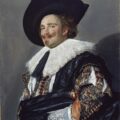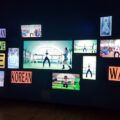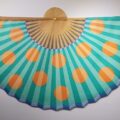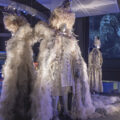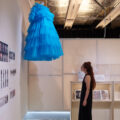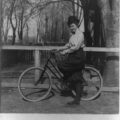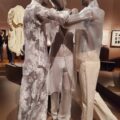Review – 150 Years of the Royal School of Needlework: Crown to Catwalk
August 16, 2022Crown to Catwalk is a retrospective of 150 years of the Royal School of Needlework. This institution, originally founded in 1872 to teach women a useful occupation, has been in existence ever since. This exhibition traces its course from the original school set up by Princess Helena, Queen Victoria’s fifth child, to today’s creations.
Princess Helena set up the workrooms for quite an interesting reason: although ladies still embroidered as a hobby, the fashion was for Berlin wool work. This was a technique worked predominantly in one stitch, on canvas. She felt that the beautiful tradition of many different kinds of English stitching was being erased. So this venture was to resurrect those traditions, and at the same time, train women for the jobs she had just created a demand for. In fact, it was not just a school but workrooms too, a commercial venture in itself. And she succeeded. She got together a great panel to sit on the board, and persuaded or commissioned the famous designers of the day to contribute work.
It helped that England at the time was undergoing a renaissance of handicrafts, authored in part by the Arts and Crafts movement and its emphasis on hand-made over mass machine-manufactured. The RSN initially created work mainly for interiors – curtains, cushions and upholstery – and it was done to order. Design cards were sent out to prospective clients directly. They were available to browse at shops like Liberty. Work was then commissioned from there. It would certainly not have been cheap.
The Royal School of Needlework – teaching military and church embroidery
Later on, the school evolved into teaching military and church embroidery. It was also commissioned, at very short notice, to create the funeral pall for Queen Victoria’s coffin. The task was accomplished in under 48 hours by many teams of women working continuously. They also created King Edward VII’s coronation cloak, displayed here in all its golden finery.
Today the embroidery courses are mainly accessed by hobbyists, although some go on to work in fashion. In the last ten years embroidery was beginning its rehabilitation from an old fashioned, stuffy pursuit. But in lockdown, of course, its popularity soared. The RSN has a lot of courses, based, rather impressively, at Hampton Court Palace. You can also access them online.
Royal School of Needlework – Beautiful Embroidery
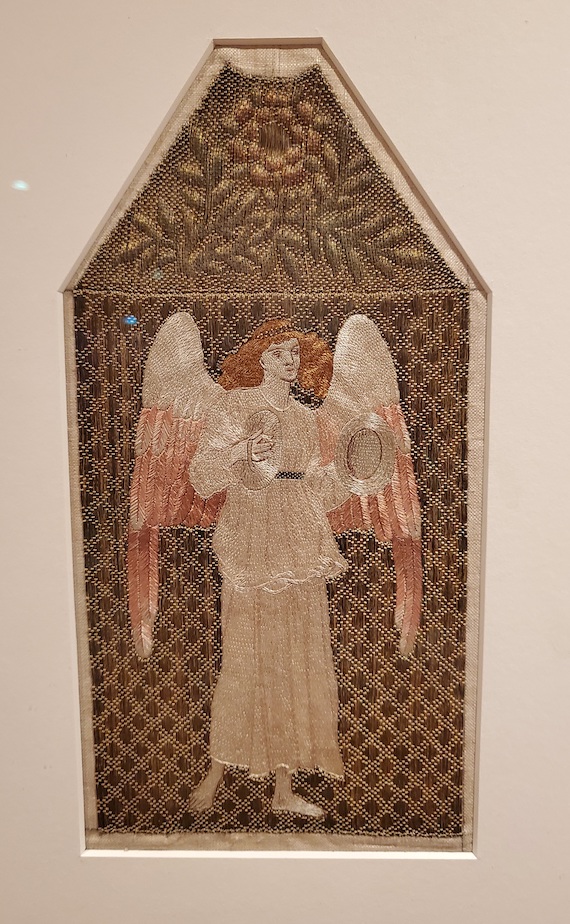
Elizabeth Burden’s work. Photo Genevieve Jones, from the exhibition mentioned.
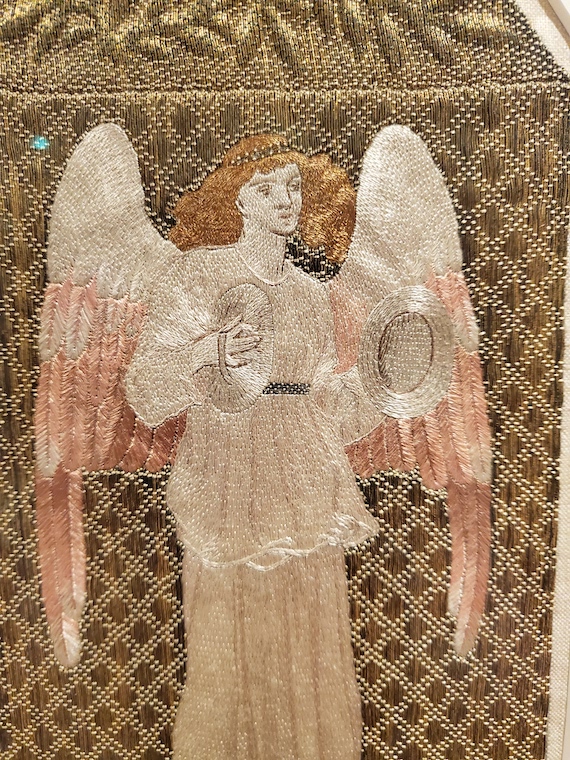
Closeup of the stitching. Photo Genevieve Jones, from the exhibition mentioned.
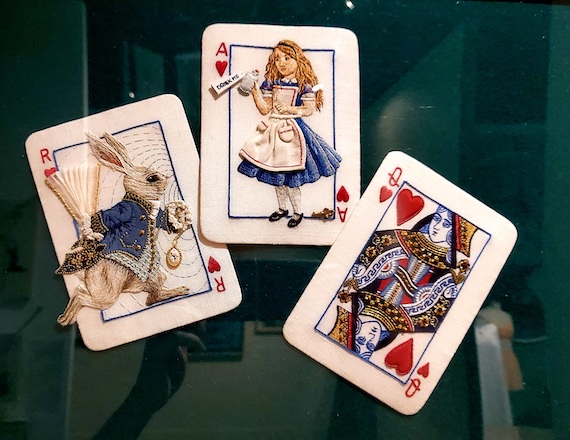
Photo Genevieve Jones, from the exhibition mentioned.
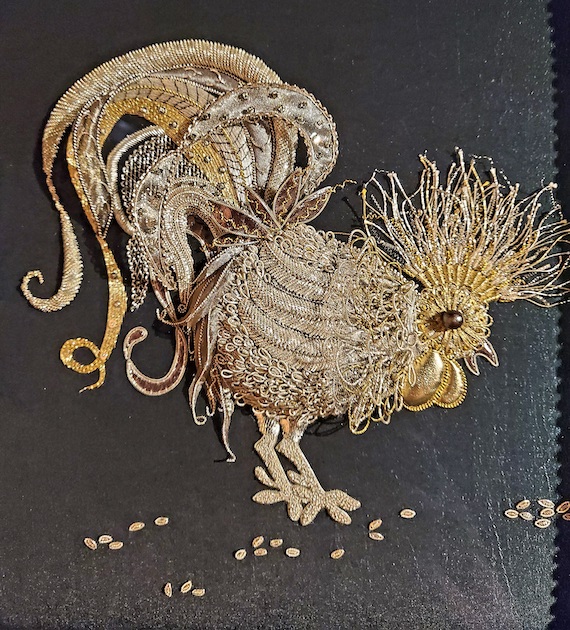
Goldwork chicken. Photo Genevieve Jones, from the exhibition mentioned.
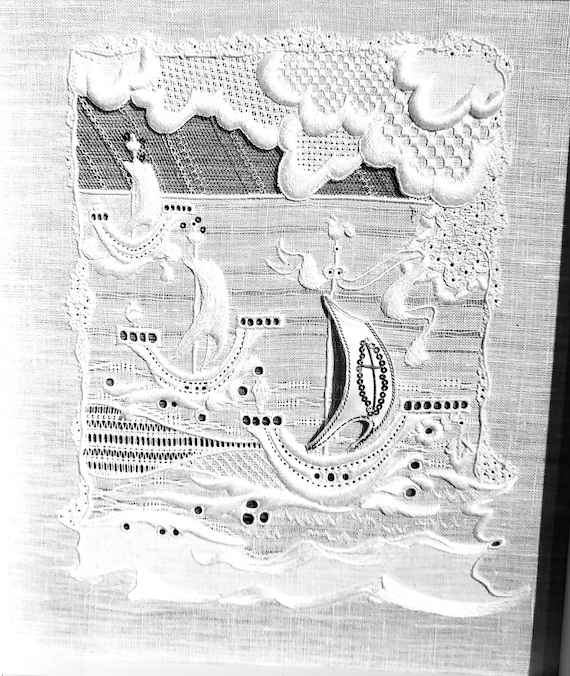
Whitework scene. Photo Genevieve Jones, from the exhibition mentioned.
The most beautiful work in the whole exhibition is by Elizabeth Burden. This is an incredibly fine image of an angel, based on a William Morris design for stained glass. It captures so well the wavy hair of the figure. The tunic they wear seems energetically in motion as they clash a pair of cymbals. The main stitch used is Opus Plumarium, renamed Burden stitch as it was her favourite.
The background, now tarnished, would originally have been bright gold. It is made with under-embroidery at the top. You can just see the faint red of the flower and green of the leaves. These provide both the padded texture and shimmering colour that shows through the gold. On top are laid fine parallel gold threads. These are couched down, or caught, at regular intervals with very tiny horizontal stitches. This technique is tricky, especially at such a scale. It’s hard to keep the tension right and the pattern even. This is a virtuoso piece. Elizabeth Burden went on to teach in the Royal School of Needlework.
Royal School of Needlework – The Embroiderers Themselves
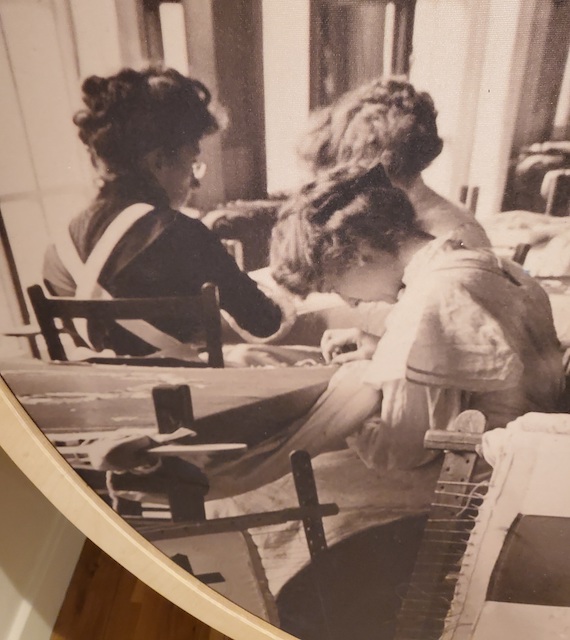
Lovely hairstyles. Photo Genevieve Jones, from the exhibition mentioned.
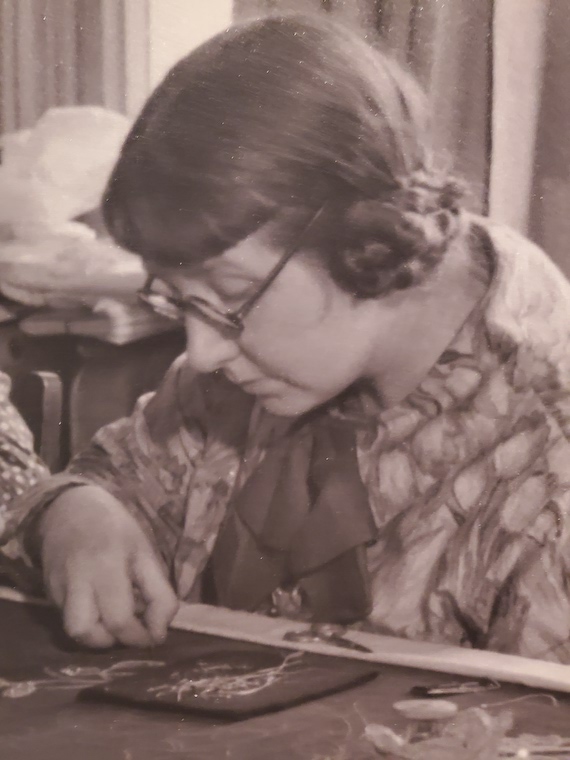
A worker or student in the 1930s. Photo Genevieve Jones, from the exhibition mentioned. Original photo from the RSN archives.
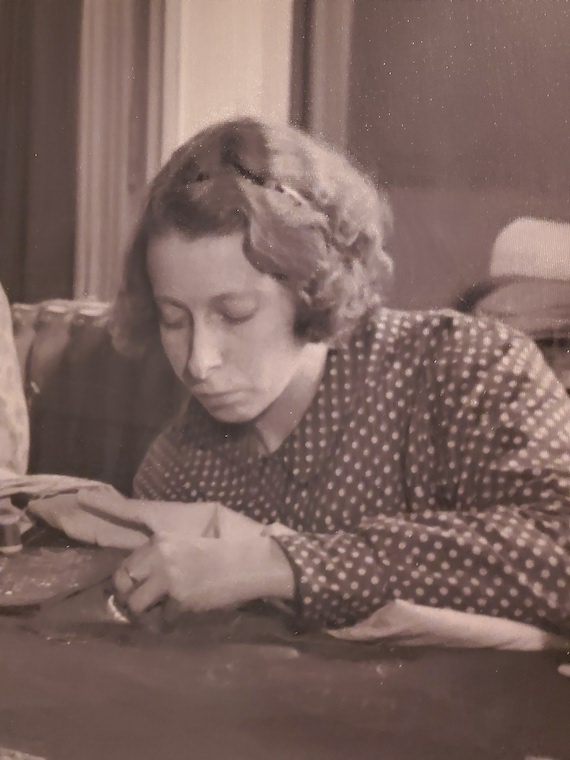
A worker or student in the 1930s. Photo Genevieve Jones, from the exhibition mentioned. Original photo from the RSN archives.
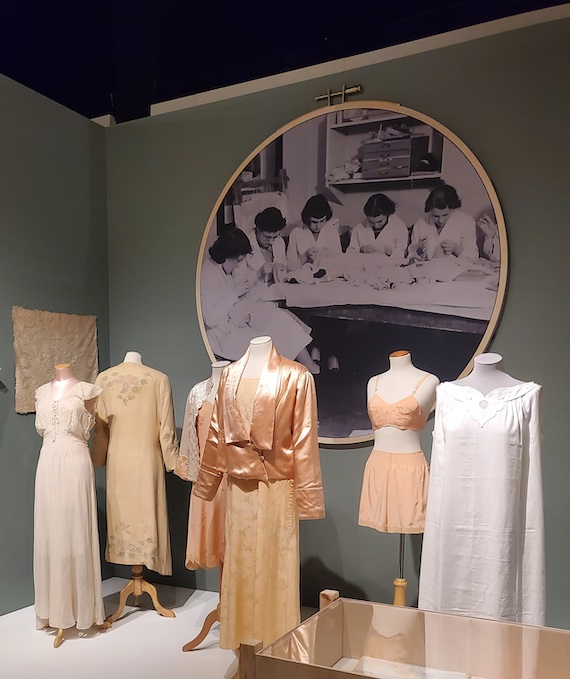
1930s embroiderers along with nightwear and underwear from the period. Photo Genevieve Jones, from the exhibition mentioned.
What was also fascinating in the exhibition was the photos of the workroom, offering glimpses of working-class women’s hairstyles and clothes (mainly hairstyles) as they bent over their work. One early series of sketches of the women at work on their various tasks for an Edwardian newspaper showed them all slender and graceful with the same delicate profile and perfect, Gibson Girl hair. The reality was, of course, considerably more variation in face and figure but actually, the prevailing hairstyle was indeed long, wavy hair, softly gathered into a bun on top. The photo from the 1930s shows a row of much sleeker heads – and by now all the workers wear official-looking matching white coats over their everyday clothes.
For the gardeners out there
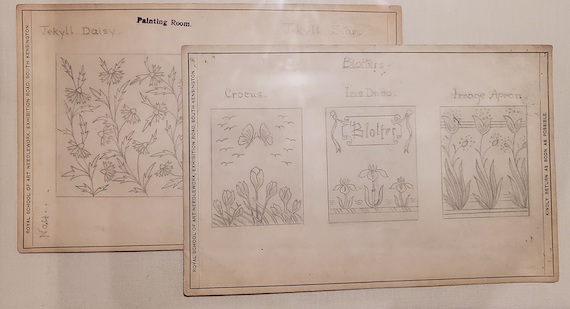
Gertrude Jekyll’s designs. Photo Genevieve Jones, from the exhibition mentioned.
And lovers of garden history. The great garden designer, Gertrude Jekyll, worked with Edward Lutyens in one of the most famous partnerships of the Arts and Crafts movement. Before finding fame, Jekyll started out in interiors. Trained in painting, particularly watercolours, she designed many embroideries for the nascent School of Needlework. She did not, as far as I know, embroider, as embroidery design and execution are two distinct skill sets. The embroidery designs shown here by Jekyll are endearingly unsophisticated. And to be honest, not discernibly different from hundreds in a similar style. But the floral borders she envisaged for tablecloths must have influenced her famous flower borders in country house gardens later on.
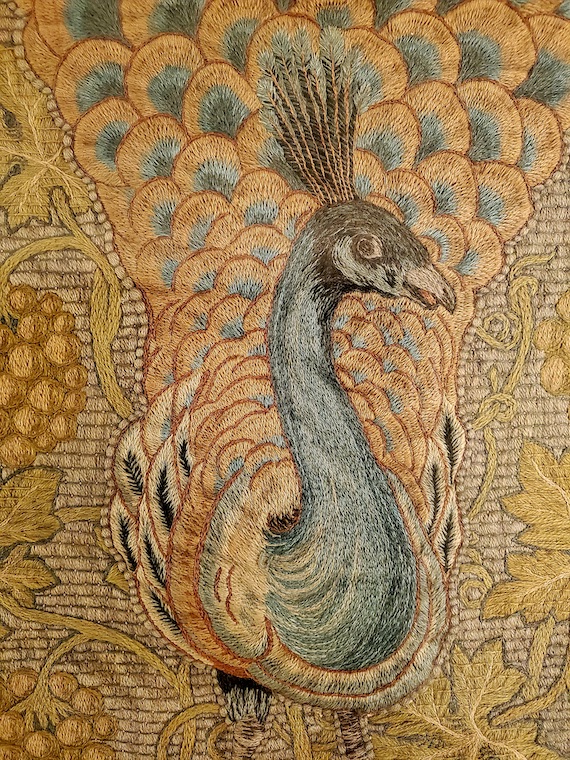
Embroidered peacock, after a William Morris design. Photo Genevieve Jones, from the exhibition mentioned.
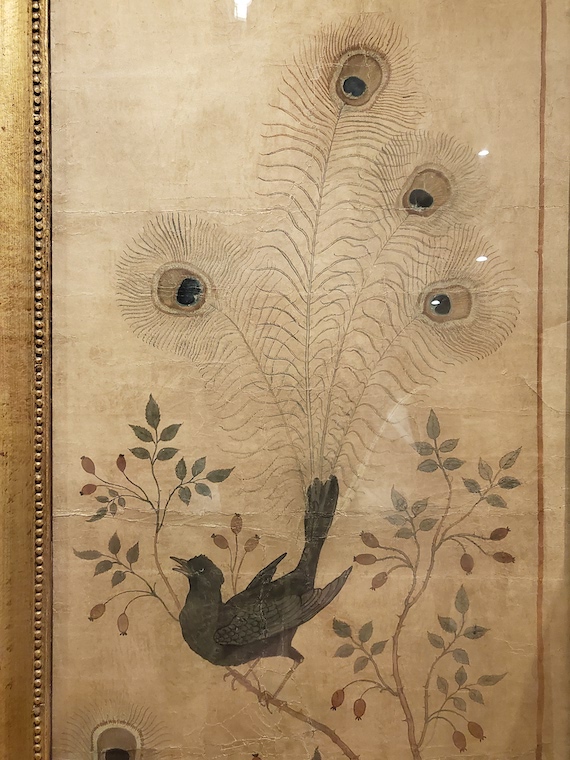
Walter Crane design for the RSN. Photo Genevieve Jones, from the exhibition mentioned.
Perhaps less surprisingly, the illustrator Walter Crane also designed panels and in one case a waistcoat for the Royal School of Needlework. And although William Morris did not specifically create works for the school, he did agree to some of his famous works, including “Peacock and Vine”, being rendered in embroidery by their workers. This piece was made up as a panel and displayed at overseas exhibitions, which brought Morris a lot of publicity. In this case, the peacock has a particularly naughty face.
Expressions in Embroidery
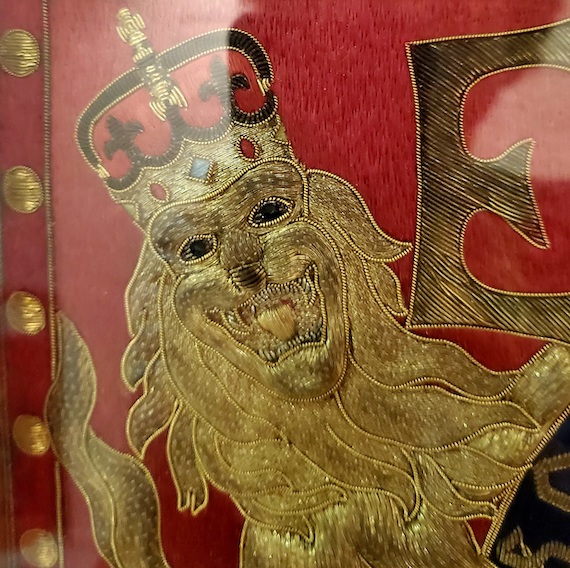
Photo Genevieve Jones, from the exhibition mentioned.
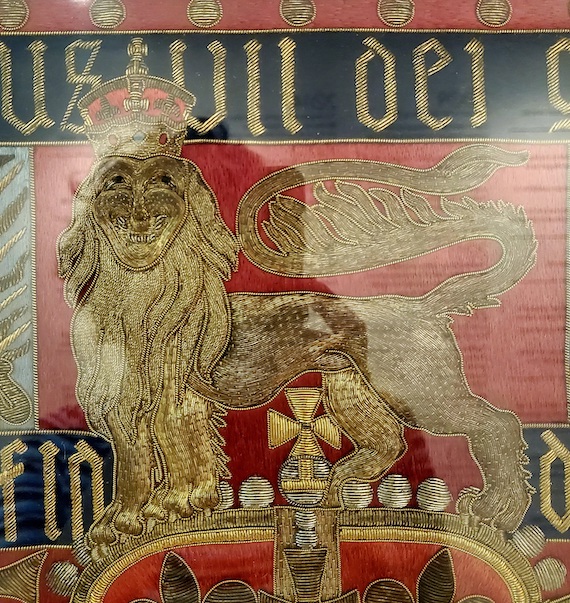
Photo Genevieve Jones, from the exhibition mentioned.
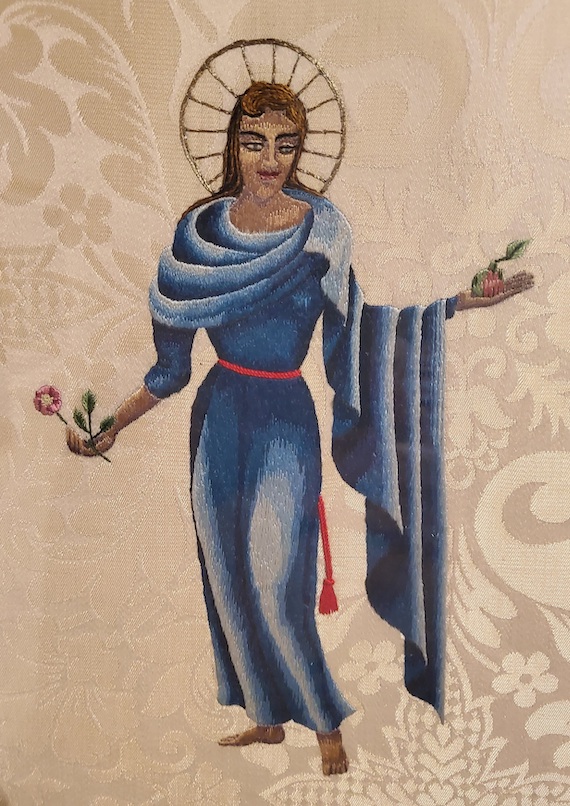
Photo Genevieve Jones, from the exhibition mentioned.
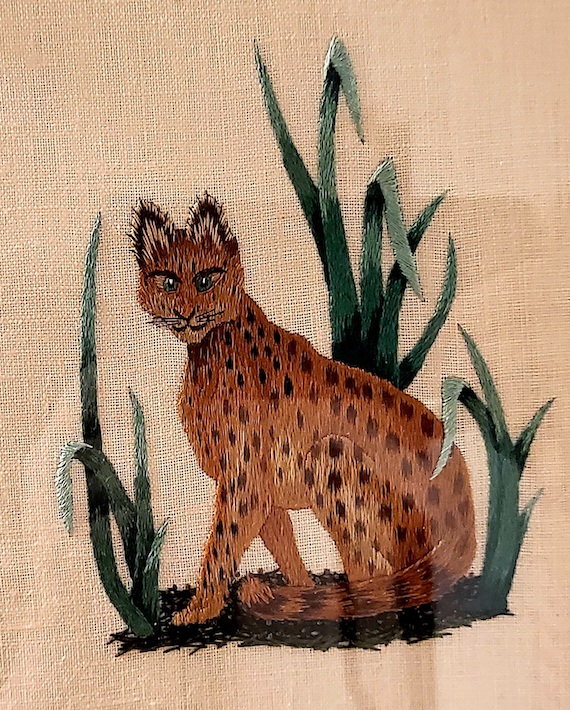
Photo Genevieve Jones, from the exhibition mentioned.
Talking of faces, they seem to be the hardest thing for an embroiderer to pull off. They are difficult in any media. But while an embroidered depiction of clothing can be particularly exquisitely silk-shaded and appear to fall just like the real thing, it is jarring to see it surmounted by what looks like a potato with features scrawled on it in marker pen.
Of course, there is a long tradition of animals with hilarious expressions in medieval painting and embroidery. It seems to be just how animals looked in medieval minds. Particularly lions. I always thought it was perhaps because nobody in England in the middle ages had seen a real lion (although they had seen cats and they are fairly close). But embroiderers of the 1930s and beyond carried on this tradition. There are derpy lions, potato-headed saints, and even a cross-eyed cheetah.
It is fascinating to see how this skill is interpreted, used, and continues to be made relevant into the present day.
150 Years of the Royal School of Needlework: Crown to Catwalk is on at the Fashion and Textile Museum until the 4th September.



